Racial Discrimination: Depression and Anxiety in High School Students
VerifiedAdded on 2023/06/05
|15
|3512
|427
Literature Review
AI Summary
This literature review investigates the correlation between racial discrimination and mental health issues, specifically anxiety and depression, among high school teenagers aged 16-19. The review highlights the adverse effects of racial discrimination, bullying, and peer pressure on adolescents' mental well-being, drawing from various research studies conducted between 2013 and 2017. It identifies key themes such as gender discrimination, mental health implications for minorities and immigrants, and the long-term consequences of facing stigmatized attitudes. The review also emphasizes the importance of education, awareness, and administrative reforms in high schools to mitigate the negative impact of racial discrimination and promote a supportive and inclusive environment for all students. The research concludes that adolescence is a sensitive phase, and creating a positive environment free from stress factors is crucial for healthy development.
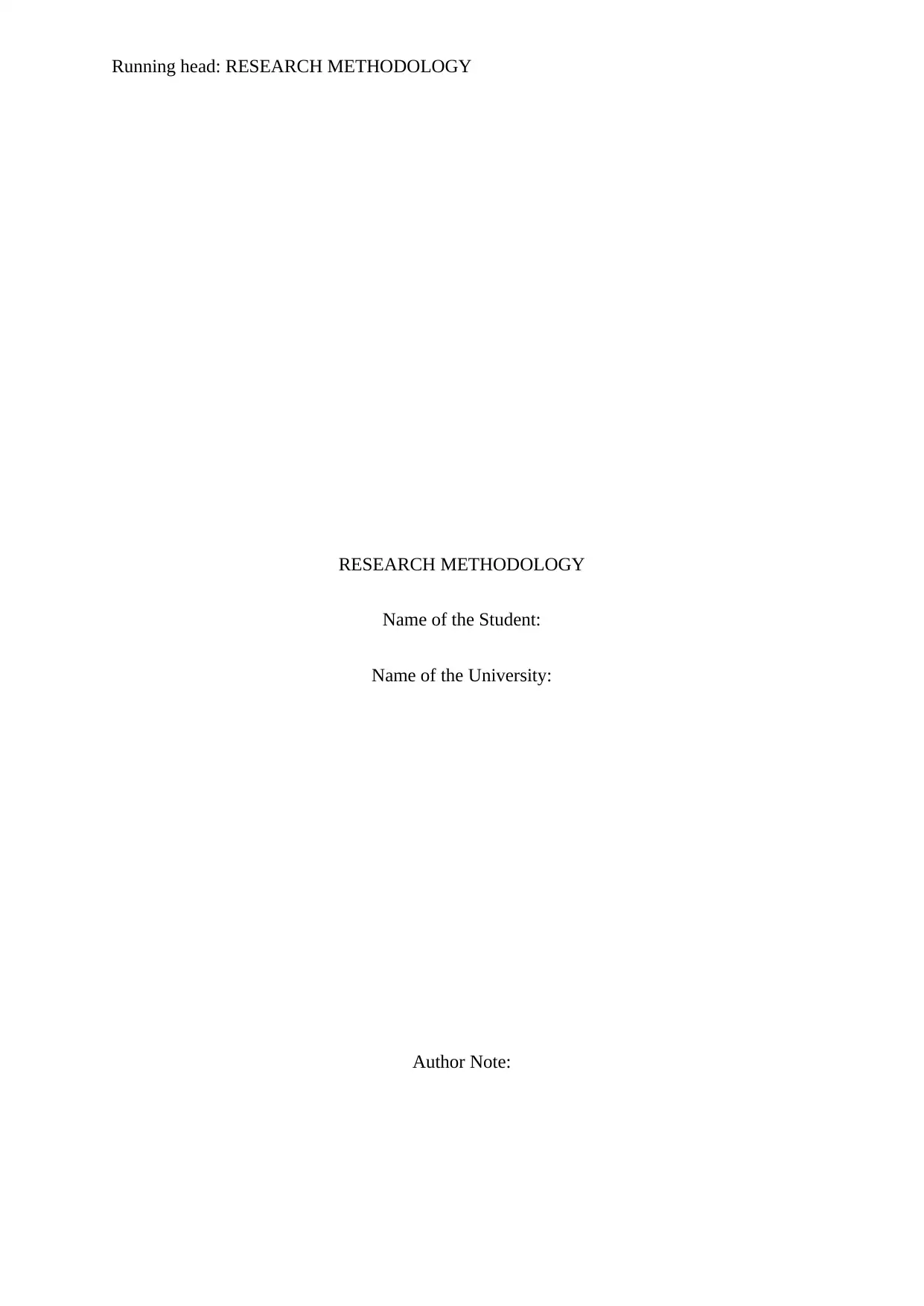
Running head: RESEARCH METHODOLOGY
RESEARCH METHODOLOGY
Name of the Student:
Name of the University:
Author Note:
RESEARCH METHODOLOGY
Name of the Student:
Name of the University:
Author Note:
Paraphrase This Document
Need a fresh take? Get an instant paraphrase of this document with our AI Paraphraser
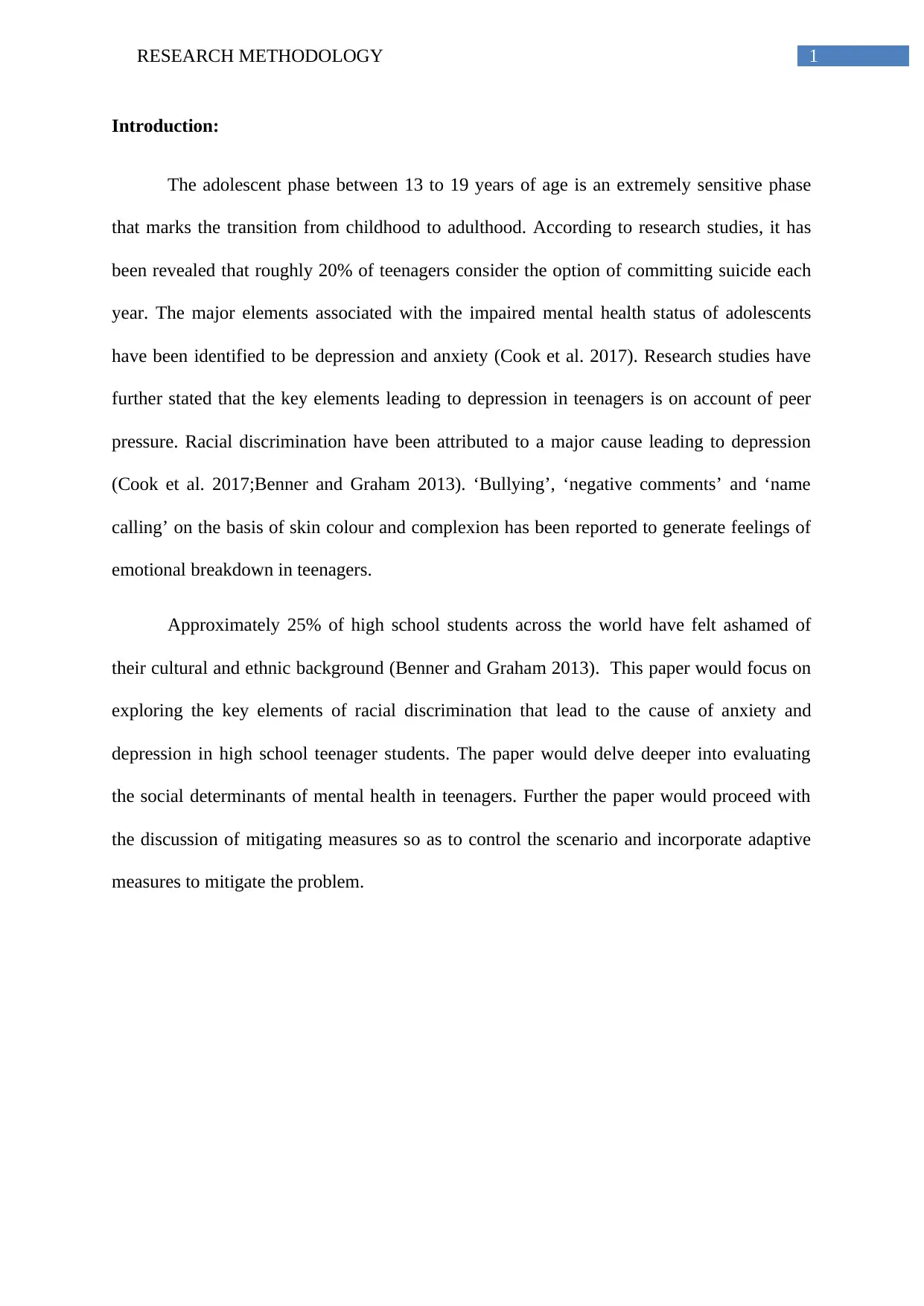
1RESEARCH METHODOLOGY
Introduction:
The adolescent phase between 13 to 19 years of age is an extremely sensitive phase
that marks the transition from childhood to adulthood. According to research studies, it has
been revealed that roughly 20% of teenagers consider the option of committing suicide each
year. The major elements associated with the impaired mental health status of adolescents
have been identified to be depression and anxiety (Cook et al. 2017). Research studies have
further stated that the key elements leading to depression in teenagers is on account of peer
pressure. Racial discrimination have been attributed to a major cause leading to depression
(Cook et al. 2017;Benner and Graham 2013). ‘Bullying’, ‘negative comments’ and ‘name
calling’ on the basis of skin colour and complexion has been reported to generate feelings of
emotional breakdown in teenagers.
Approximately 25% of high school students across the world have felt ashamed of
their cultural and ethnic background (Benner and Graham 2013). This paper would focus on
exploring the key elements of racial discrimination that lead to the cause of anxiety and
depression in high school teenager students. The paper would delve deeper into evaluating
the social determinants of mental health in teenagers. Further the paper would proceed with
the discussion of mitigating measures so as to control the scenario and incorporate adaptive
measures to mitigate the problem.
Introduction:
The adolescent phase between 13 to 19 years of age is an extremely sensitive phase
that marks the transition from childhood to adulthood. According to research studies, it has
been revealed that roughly 20% of teenagers consider the option of committing suicide each
year. The major elements associated with the impaired mental health status of adolescents
have been identified to be depression and anxiety (Cook et al. 2017). Research studies have
further stated that the key elements leading to depression in teenagers is on account of peer
pressure. Racial discrimination have been attributed to a major cause leading to depression
(Cook et al. 2017;Benner and Graham 2013). ‘Bullying’, ‘negative comments’ and ‘name
calling’ on the basis of skin colour and complexion has been reported to generate feelings of
emotional breakdown in teenagers.
Approximately 25% of high school students across the world have felt ashamed of
their cultural and ethnic background (Benner and Graham 2013). This paper would focus on
exploring the key elements of racial discrimination that lead to the cause of anxiety and
depression in high school teenager students. The paper would delve deeper into evaluating
the social determinants of mental health in teenagers. Further the paper would proceed with
the discussion of mitigating measures so as to control the scenario and incorporate adaptive
measures to mitigate the problem.
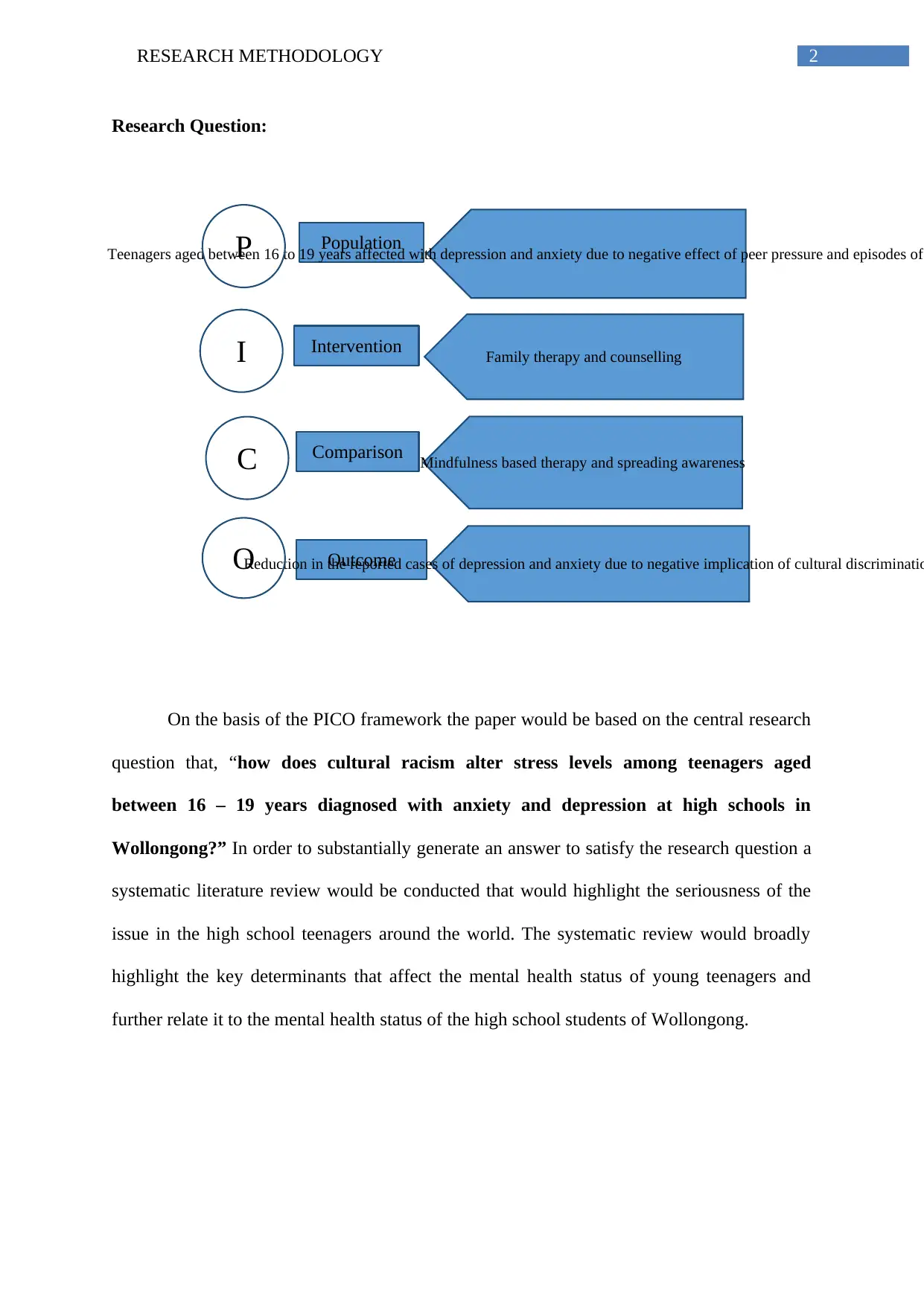
2RESEARCH METHODOLOGY
Population
Teenagers aged between 16 to 19 years affected with depression and anxiety due to negative effect of peer pressure and episodes ofP
Intervention Family therapy and counsellingI
Comparison Mindfulness based therapy and spreading awarenessC
OutcomeReduction in the reported cases of depression and anxiety due to negative implication of cultural discriminatioO
Research Question:
On the basis of the PICO framework the paper would be based on the central research
question that, “how does cultural racism alter stress levels among teenagers aged
between 16 – 19 years diagnosed with anxiety and depression at high schools in
Wollongong?” In order to substantially generate an answer to satisfy the research question a
systematic literature review would be conducted that would highlight the seriousness of the
issue in the high school teenagers around the world. The systematic review would broadly
highlight the key determinants that affect the mental health status of young teenagers and
further relate it to the mental health status of the high school students of Wollongong.
Population
Teenagers aged between 16 to 19 years affected with depression and anxiety due to negative effect of peer pressure and episodes ofP
Intervention Family therapy and counsellingI
Comparison Mindfulness based therapy and spreading awarenessC
OutcomeReduction in the reported cases of depression and anxiety due to negative implication of cultural discriminatioO
Research Question:
On the basis of the PICO framework the paper would be based on the central research
question that, “how does cultural racism alter stress levels among teenagers aged
between 16 – 19 years diagnosed with anxiety and depression at high schools in
Wollongong?” In order to substantially generate an answer to satisfy the research question a
systematic literature review would be conducted that would highlight the seriousness of the
issue in the high school teenagers around the world. The systematic review would broadly
highlight the key determinants that affect the mental health status of young teenagers and
further relate it to the mental health status of the high school students of Wollongong.
⊘ This is a preview!⊘
Do you want full access?
Subscribe today to unlock all pages.

Trusted by 1+ million students worldwide
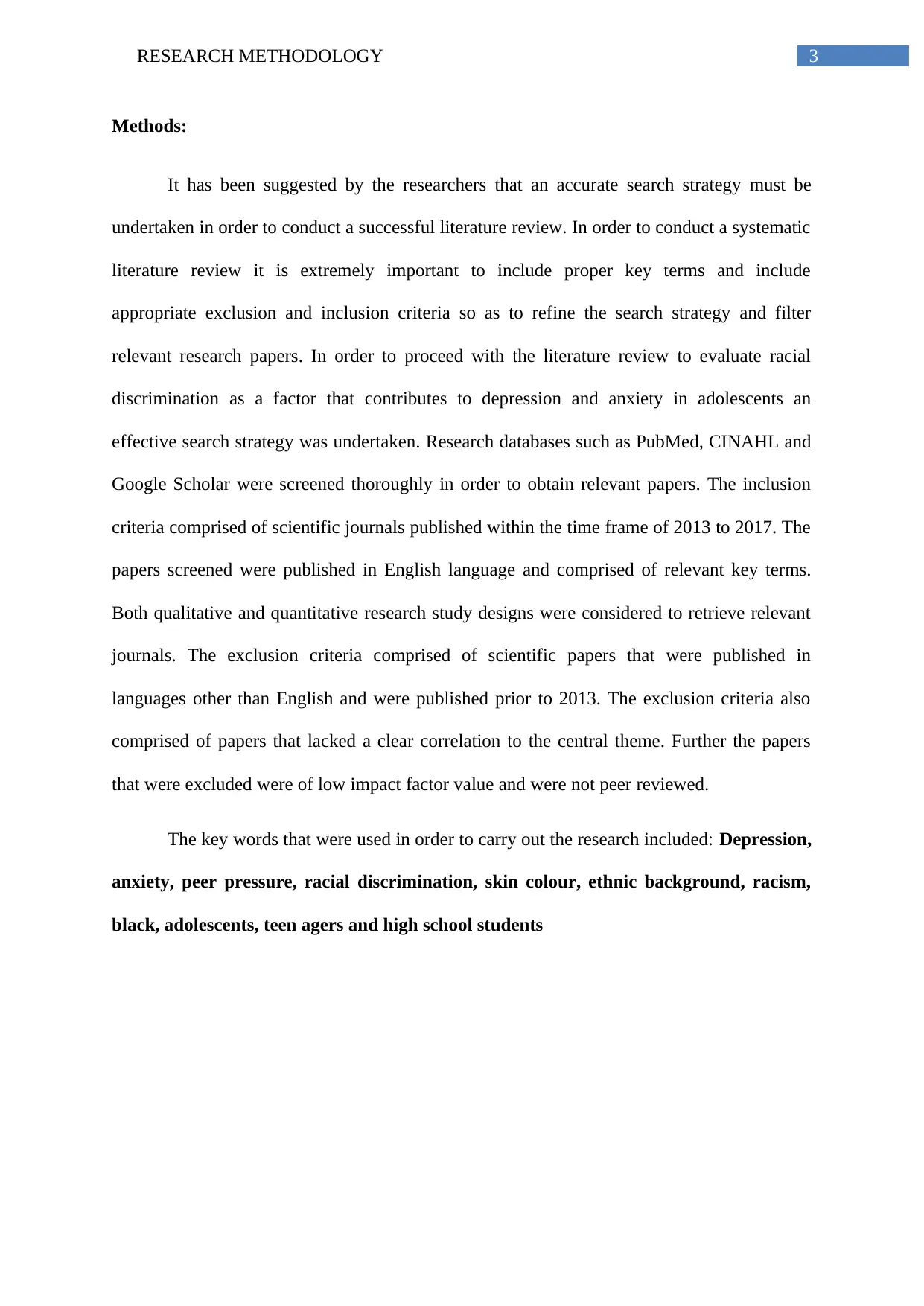
3RESEARCH METHODOLOGY
Methods:
It has been suggested by the researchers that an accurate search strategy must be
undertaken in order to conduct a successful literature review. In order to conduct a systematic
literature review it is extremely important to include proper key terms and include
appropriate exclusion and inclusion criteria so as to refine the search strategy and filter
relevant research papers. In order to proceed with the literature review to evaluate racial
discrimination as a factor that contributes to depression and anxiety in adolescents an
effective search strategy was undertaken. Research databases such as PubMed, CINAHL and
Google Scholar were screened thoroughly in order to obtain relevant papers. The inclusion
criteria comprised of scientific journals published within the time frame of 2013 to 2017. The
papers screened were published in English language and comprised of relevant key terms.
Both qualitative and quantitative research study designs were considered to retrieve relevant
journals. The exclusion criteria comprised of scientific papers that were published in
languages other than English and were published prior to 2013. The exclusion criteria also
comprised of papers that lacked a clear correlation to the central theme. Further the papers
that were excluded were of low impact factor value and were not peer reviewed.
The key words that were used in order to carry out the research included: Depression,
anxiety, peer pressure, racial discrimination, skin colour, ethnic background, racism,
black, adolescents, teen agers and high school students
Methods:
It has been suggested by the researchers that an accurate search strategy must be
undertaken in order to conduct a successful literature review. In order to conduct a systematic
literature review it is extremely important to include proper key terms and include
appropriate exclusion and inclusion criteria so as to refine the search strategy and filter
relevant research papers. In order to proceed with the literature review to evaluate racial
discrimination as a factor that contributes to depression and anxiety in adolescents an
effective search strategy was undertaken. Research databases such as PubMed, CINAHL and
Google Scholar were screened thoroughly in order to obtain relevant papers. The inclusion
criteria comprised of scientific journals published within the time frame of 2013 to 2017. The
papers screened were published in English language and comprised of relevant key terms.
Both qualitative and quantitative research study designs were considered to retrieve relevant
journals. The exclusion criteria comprised of scientific papers that were published in
languages other than English and were published prior to 2013. The exclusion criteria also
comprised of papers that lacked a clear correlation to the central theme. Further the papers
that were excluded were of low impact factor value and were not peer reviewed.
The key words that were used in order to carry out the research included: Depression,
anxiety, peer pressure, racial discrimination, skin colour, ethnic background, racism,
black, adolescents, teen agers and high school students
Paraphrase This Document
Need a fresh take? Get an instant paraphrase of this document with our AI Paraphraser
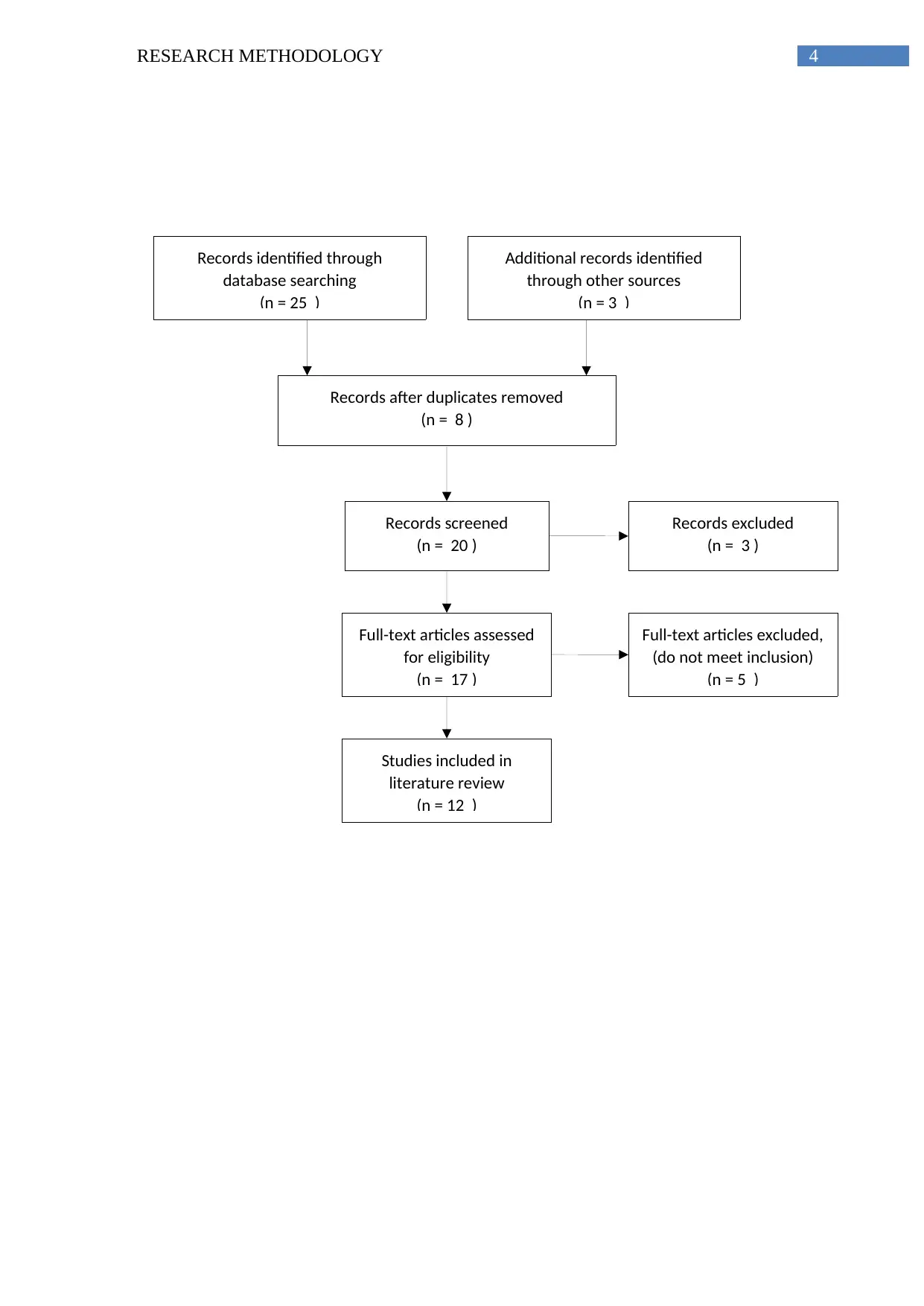
4RESEARCH METHODOLOGY
Records identified through
database searching
(n = 25 )
Additional records identified
through other sources
(n = 3 )
Records after duplicates removed
(n = 8 )
Records screened
(n = 20 )
Records excluded
(n = 3 )
Full-text articles assessed
for eligibility
(n = 17 )
Full-text articles excluded,
(do not meet inclusion)
(n = 5 )
Studies included in
literature review
(n = 12 )
Records identified through
database searching
(n = 25 )
Additional records identified
through other sources
(n = 3 )
Records after duplicates removed
(n = 8 )
Records screened
(n = 20 )
Records excluded
(n = 3 )
Full-text articles assessed
for eligibility
(n = 17 )
Full-text articles excluded,
(do not meet inclusion)
(n = 5 )
Studies included in
literature review
(n = 12 )

5RESEARCH METHODOLOGY
Results:
Self-reflection:
Racial discrimination has been perceived as an element of negative peer influence that
leads to depression and stress in young teenagers across the world. Researchers all over the
world have tried to evaluate the negative implication of mental health based on racial
discrimination in young students. According to the authors Shervin, Ehsan, Cleopatra and
Marc (2017), gender discrimination has been witnessed at the maximum level in students
who are black. The research study was based on a longitudinal design. It aimed to evaluate
the negative experience of being bullied in school because of the racial and cultural
background and trace the mental state implication on transitioning to adulthood. The study
proceeded for a span of 10 years in order to detect the mental health implication of the
adolescents transitioning to adulthood (Shervin et al. 2017).
Mental health status of minorities and immigrants:
Anxiety and depression were reported to be the major implications of negative
childhood experience (Lambert et al. 2014). Racial discrimination have been explained as the
presence of a stigmatized behaviour of the society in order to humiliate individuals based
upon their outward appearance such as their complexion, their cultural root or the manner in
which they carry themselves (Cook et al. 2017). A study conducted by English et al. (2014)
highlighted that most of the individuals of African origin who were victims of racial
discrimination displayed symptoms of depression a year later. The paper further correlated
the score 7 of racial discrimination to the depression score level 8 a year later. Further, the
authors have also stated that the initial phase of depression affects the adolescents at an early
age. As stated by Tummala-Nara, Pratyusha, Cladius and Milena (2013), racial
discrimination has also been reported to exist between foreign-born U.S individuals and U.S
Results:
Self-reflection:
Racial discrimination has been perceived as an element of negative peer influence that
leads to depression and stress in young teenagers across the world. Researchers all over the
world have tried to evaluate the negative implication of mental health based on racial
discrimination in young students. According to the authors Shervin, Ehsan, Cleopatra and
Marc (2017), gender discrimination has been witnessed at the maximum level in students
who are black. The research study was based on a longitudinal design. It aimed to evaluate
the negative experience of being bullied in school because of the racial and cultural
background and trace the mental state implication on transitioning to adulthood. The study
proceeded for a span of 10 years in order to detect the mental health implication of the
adolescents transitioning to adulthood (Shervin et al. 2017).
Mental health status of minorities and immigrants:
Anxiety and depression were reported to be the major implications of negative
childhood experience (Lambert et al. 2014). Racial discrimination have been explained as the
presence of a stigmatized behaviour of the society in order to humiliate individuals based
upon their outward appearance such as their complexion, their cultural root or the manner in
which they carry themselves (Cook et al. 2017). A study conducted by English et al. (2014)
highlighted that most of the individuals of African origin who were victims of racial
discrimination displayed symptoms of depression a year later. The paper further correlated
the score 7 of racial discrimination to the depression score level 8 a year later. Further, the
authors have also stated that the initial phase of depression affects the adolescents at an early
age. As stated by Tummala-Nara, Pratyusha, Cladius and Milena (2013), racial
discrimination has also been reported to exist between foreign-born U.S individuals and U.S
⊘ This is a preview!⊘
Do you want full access?
Subscribe today to unlock all pages.

Trusted by 1+ million students worldwide
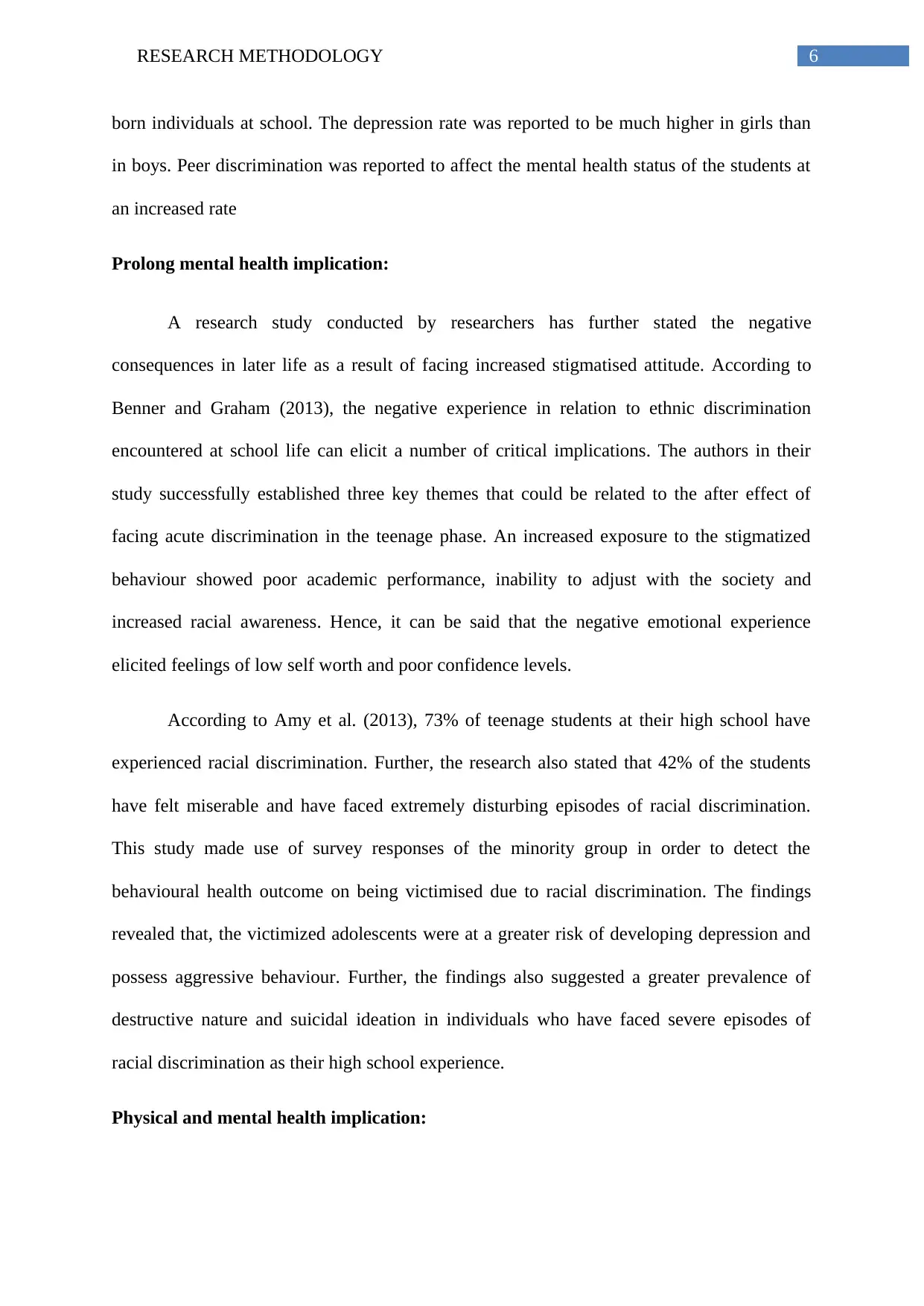
6RESEARCH METHODOLOGY
born individuals at school. The depression rate was reported to be much higher in girls than
in boys. Peer discrimination was reported to affect the mental health status of the students at
an increased rate
Prolong mental health implication:
A research study conducted by researchers has further stated the negative
consequences in later life as a result of facing increased stigmatised attitude. According to
Benner and Graham (2013), the negative experience in relation to ethnic discrimination
encountered at school life can elicit a number of critical implications. The authors in their
study successfully established three key themes that could be related to the after effect of
facing acute discrimination in the teenage phase. An increased exposure to the stigmatized
behaviour showed poor academic performance, inability to adjust with the society and
increased racial awareness. Hence, it can be said that the negative emotional experience
elicited feelings of low self worth and poor confidence levels.
According to Amy et al. (2013), 73% of teenage students at their high school have
experienced racial discrimination. Further, the research also stated that 42% of the students
have felt miserable and have faced extremely disturbing episodes of racial discrimination.
This study made use of survey responses of the minority group in order to detect the
behavioural health outcome on being victimised due to racial discrimination. The findings
revealed that, the victimized adolescents were at a greater risk of developing depression and
possess aggressive behaviour. Further, the findings also suggested a greater prevalence of
destructive nature and suicidal ideation in individuals who have faced severe episodes of
racial discrimination as their high school experience.
Physical and mental health implication:
born individuals at school. The depression rate was reported to be much higher in girls than
in boys. Peer discrimination was reported to affect the mental health status of the students at
an increased rate
Prolong mental health implication:
A research study conducted by researchers has further stated the negative
consequences in later life as a result of facing increased stigmatised attitude. According to
Benner and Graham (2013), the negative experience in relation to ethnic discrimination
encountered at school life can elicit a number of critical implications. The authors in their
study successfully established three key themes that could be related to the after effect of
facing acute discrimination in the teenage phase. An increased exposure to the stigmatized
behaviour showed poor academic performance, inability to adjust with the society and
increased racial awareness. Hence, it can be said that the negative emotional experience
elicited feelings of low self worth and poor confidence levels.
According to Amy et al. (2013), 73% of teenage students at their high school have
experienced racial discrimination. Further, the research also stated that 42% of the students
have felt miserable and have faced extremely disturbing episodes of racial discrimination.
This study made use of survey responses of the minority group in order to detect the
behavioural health outcome on being victimised due to racial discrimination. The findings
revealed that, the victimized adolescents were at a greater risk of developing depression and
possess aggressive behaviour. Further, the findings also suggested a greater prevalence of
destructive nature and suicidal ideation in individuals who have faced severe episodes of
racial discrimination as their high school experience.
Physical and mental health implication:
Paraphrase This Document
Need a fresh take? Get an instant paraphrase of this document with our AI Paraphraser

7RESEARCH METHODOLOGY
According to a research study conducted by Gibbons et al. (2014), the impact of racial
discrimination elicits both physical and mental health implications in an individual. The
research study analysed the negative impact on physical and mental health and tried to
evaluate which aspect was harmed more. The findings stated that both the physical and
mental health was equally affected and in order to find relief adolescents indulged in
substance abuse.
Unhealthy transition to adulthood:
According to Tiffany Yip (2015), negative implications of perceived racial
discrimination leads to the prevalence of depressive and dissociative symptoms in young
teenagers. The study has further reported that individuals belonging to the minority
community have experienced acute incidences of racial discrimination that has disrupted the
sleep quality and the sleep pattern of them. The study further states that the symptoms of
depression and anxiety increases more as the individuals transition from adolescence phase to
adulthood. Therefore, it can be said that there have been ample evidence provided by the
scientific literatures to predict a correlation between the existence of a relationship between
peer pressure, racial discrimination and prevalence of depression and anxiety.
Analysis:
Present Scenario:
On closely evaluating the findings of the research papers it can be said that racial
discrimination is a serious concern among adolescent students that affect their mental health
status. The research papers that were reviewed talked about the rising incidences of racial
discrimination in high schools and the negative implication on the mental as well as physical
health status of the adolescents. In order to help the teenagers belonging to the minor
community cope up with the problem, various measures can be undertaken.
According to a research study conducted by Gibbons et al. (2014), the impact of racial
discrimination elicits both physical and mental health implications in an individual. The
research study analysed the negative impact on physical and mental health and tried to
evaluate which aspect was harmed more. The findings stated that both the physical and
mental health was equally affected and in order to find relief adolescents indulged in
substance abuse.
Unhealthy transition to adulthood:
According to Tiffany Yip (2015), negative implications of perceived racial
discrimination leads to the prevalence of depressive and dissociative symptoms in young
teenagers. The study has further reported that individuals belonging to the minority
community have experienced acute incidences of racial discrimination that has disrupted the
sleep quality and the sleep pattern of them. The study further states that the symptoms of
depression and anxiety increases more as the individuals transition from adolescence phase to
adulthood. Therefore, it can be said that there have been ample evidence provided by the
scientific literatures to predict a correlation between the existence of a relationship between
peer pressure, racial discrimination and prevalence of depression and anxiety.
Analysis:
Present Scenario:
On closely evaluating the findings of the research papers it can be said that racial
discrimination is a serious concern among adolescent students that affect their mental health
status. The research papers that were reviewed talked about the rising incidences of racial
discrimination in high schools and the negative implication on the mental as well as physical
health status of the adolescents. In order to help the teenagers belonging to the minor
community cope up with the problem, various measures can be undertaken.
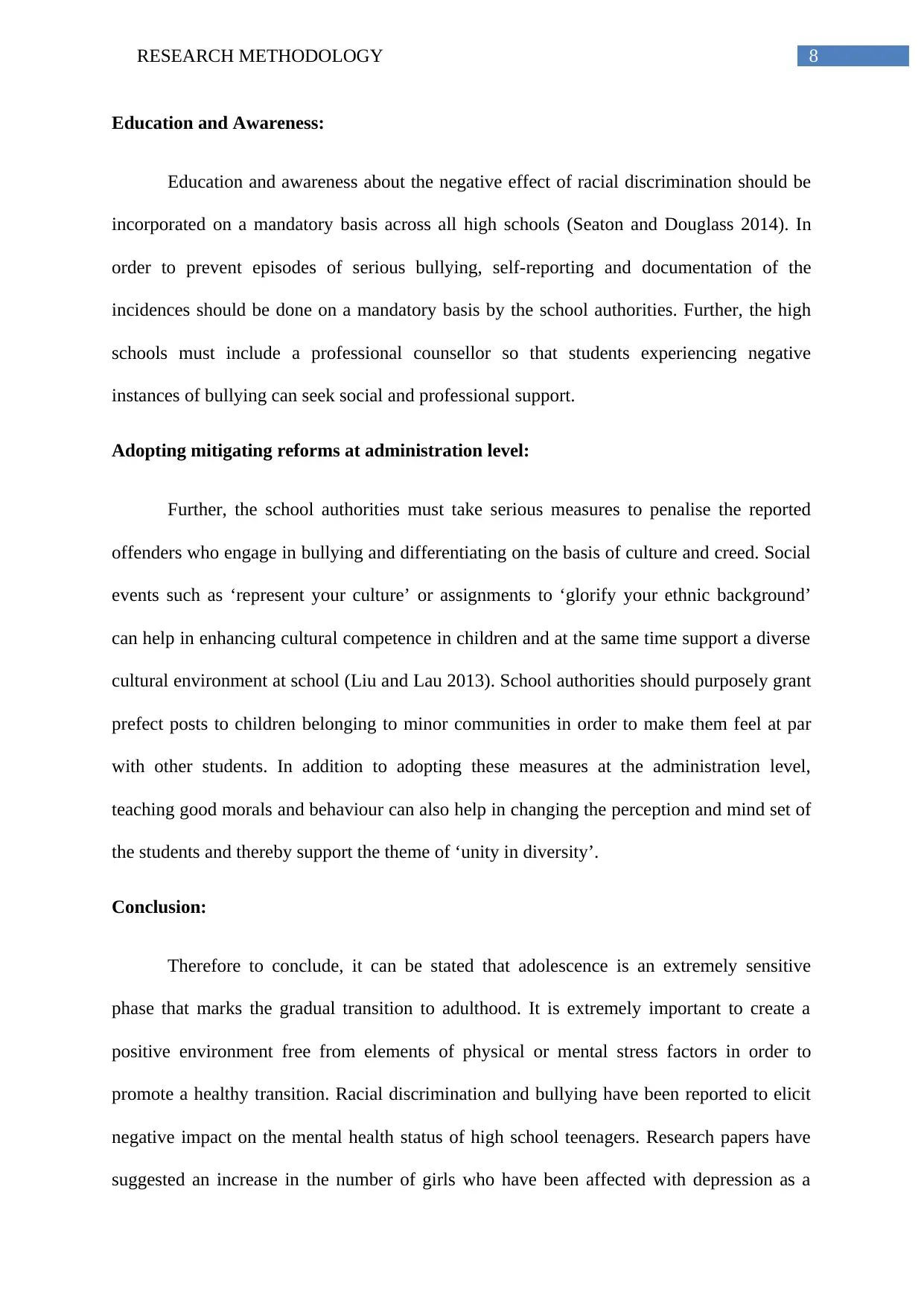
8RESEARCH METHODOLOGY
Education and Awareness:
Education and awareness about the negative effect of racial discrimination should be
incorporated on a mandatory basis across all high schools (Seaton and Douglass 2014). In
order to prevent episodes of serious bullying, self-reporting and documentation of the
incidences should be done on a mandatory basis by the school authorities. Further, the high
schools must include a professional counsellor so that students experiencing negative
instances of bullying can seek social and professional support.
Adopting mitigating reforms at administration level:
Further, the school authorities must take serious measures to penalise the reported
offenders who engage in bullying and differentiating on the basis of culture and creed. Social
events such as ‘represent your culture’ or assignments to ‘glorify your ethnic background’
can help in enhancing cultural competence in children and at the same time support a diverse
cultural environment at school (Liu and Lau 2013). School authorities should purposely grant
prefect posts to children belonging to minor communities in order to make them feel at par
with other students. In addition to adopting these measures at the administration level,
teaching good morals and behaviour can also help in changing the perception and mind set of
the students and thereby support the theme of ‘unity in diversity’.
Conclusion:
Therefore to conclude, it can be stated that adolescence is an extremely sensitive
phase that marks the gradual transition to adulthood. It is extremely important to create a
positive environment free from elements of physical or mental stress factors in order to
promote a healthy transition. Racial discrimination and bullying have been reported to elicit
negative impact on the mental health status of high school teenagers. Research papers have
suggested an increase in the number of girls who have been affected with depression as a
Education and Awareness:
Education and awareness about the negative effect of racial discrimination should be
incorporated on a mandatory basis across all high schools (Seaton and Douglass 2014). In
order to prevent episodes of serious bullying, self-reporting and documentation of the
incidences should be done on a mandatory basis by the school authorities. Further, the high
schools must include a professional counsellor so that students experiencing negative
instances of bullying can seek social and professional support.
Adopting mitigating reforms at administration level:
Further, the school authorities must take serious measures to penalise the reported
offenders who engage in bullying and differentiating on the basis of culture and creed. Social
events such as ‘represent your culture’ or assignments to ‘glorify your ethnic background’
can help in enhancing cultural competence in children and at the same time support a diverse
cultural environment at school (Liu and Lau 2013). School authorities should purposely grant
prefect posts to children belonging to minor communities in order to make them feel at par
with other students. In addition to adopting these measures at the administration level,
teaching good morals and behaviour can also help in changing the perception and mind set of
the students and thereby support the theme of ‘unity in diversity’.
Conclusion:
Therefore to conclude, it can be stated that adolescence is an extremely sensitive
phase that marks the gradual transition to adulthood. It is extremely important to create a
positive environment free from elements of physical or mental stress factors in order to
promote a healthy transition. Racial discrimination and bullying have been reported to elicit
negative impact on the mental health status of high school teenagers. Research papers have
suggested an increase in the number of girls who have been affected with depression as a
⊘ This is a preview!⊘
Do you want full access?
Subscribe today to unlock all pages.

Trusted by 1+ million students worldwide

9RESEARCH METHODOLOGY
negative impact of bullying. Research papers have further indicated the prevalence of racial
discrimination between US born individuals and Foreign born US based individuals. Hence,
it can be stated that bullying based on discrimination is extremely common across all major
cities. Studies have further revealed self-destructive behaviour, suicidal ideation and
substance abuse as the negative effect of experiencing discrimination in the teenage years.
Poor academic performance and low confidence levels have been studies as the after effect of
bullying and discrimination encountered in school life.
Strategies such as education and awareness can effectively help in spreading a
positive message about the bullying and indulging in discrimination. High schools should
proactively take steps and document the cases of discrimination and take appropriate action
so as to punish the offenders. Further the appointment of a professional counsellor would
help in successfully offering social and professional support to the victims. Hence, it can be
hoped that on complying with the discussed strategies the problems related to peer pressure
and the existence of a discrimination attitude can be effectively minimised to a significant
extent.
negative impact of bullying. Research papers have further indicated the prevalence of racial
discrimination between US born individuals and Foreign born US based individuals. Hence,
it can be stated that bullying based on discrimination is extremely common across all major
cities. Studies have further revealed self-destructive behaviour, suicidal ideation and
substance abuse as the negative effect of experiencing discrimination in the teenage years.
Poor academic performance and low confidence levels have been studies as the after effect of
bullying and discrimination encountered in school life.
Strategies such as education and awareness can effectively help in spreading a
positive message about the bullying and indulging in discrimination. High schools should
proactively take steps and document the cases of discrimination and take appropriate action
so as to punish the offenders. Further the appointment of a professional counsellor would
help in successfully offering social and professional support to the victims. Hence, it can be
hoped that on complying with the discussed strategies the problems related to peer pressure
and the existence of a discrimination attitude can be effectively minimised to a significant
extent.
Paraphrase This Document
Need a fresh take? Get an instant paraphrase of this document with our AI Paraphraser

10RESEARCH METHODOLOGY
References:
Benner, A.D. and Graham, S., 2013. The antecedents and consequences of racial/ethnic
discrimination during adolescence: Does the source of discrimination
matter?. Developmental Psychology, 49(8), p.1602.
Cook, A., Spinazzola, J., Ford, J., Lanktree, C., Blaustein, M., Cloitre, M., DeRosa, R.,
Hubbard, R., Kagan, R., Liautaud, J. and Mallah, K., 2017. Complex trauma in
children and adolescents. Psychiatric annals, 35(5), pp.390-398.
English, D., Lambert, S.F. and Ialongo, N.S., 2014. Longitudinal associations between
experienced racial discrimination and depressive symptoms in African American
adolescents. Developmental psychology, 50(4), p.1190.
Lambert, S.F., Robinson, W.L. and Ialongo, N.S., 2014. The role of socially prescribed
perfectionism in the link between perceived racial discrimination and African
American adolescents’ depressive symptoms. Journal of abnormal child
psychology, 42(4), pp.577-587.
Liu, L.L. and Lau, A.S., 2013. Teaching about race/ethnicity and racism matters: An
examination of how perceived ethnic racial socialization processes are associated with
depression symptoms. Cultural Diversity and Ethnic Minority Psychology, 19(4),
p.383.
Rivas‐Drake, D., Seaton, E.K., Markstrom, C., Quintana, S., Syed, M., Lee, R.M., Schwartz,
S.J., Umaña‐Taylor, A.J., French, S., Yip, T. and Ethnic and Racial Identity in the
21st Century Study Group, 2014. Ethnic and racial identity in adolescence:
Implications for psychosocial, academic, and health outcomes. Child
development, 85(1), pp.40-57.
References:
Benner, A.D. and Graham, S., 2013. The antecedents and consequences of racial/ethnic
discrimination during adolescence: Does the source of discrimination
matter?. Developmental Psychology, 49(8), p.1602.
Cook, A., Spinazzola, J., Ford, J., Lanktree, C., Blaustein, M., Cloitre, M., DeRosa, R.,
Hubbard, R., Kagan, R., Liautaud, J. and Mallah, K., 2017. Complex trauma in
children and adolescents. Psychiatric annals, 35(5), pp.390-398.
English, D., Lambert, S.F. and Ialongo, N.S., 2014. Longitudinal associations between
experienced racial discrimination and depressive symptoms in African American
adolescents. Developmental psychology, 50(4), p.1190.
Lambert, S.F., Robinson, W.L. and Ialongo, N.S., 2014. The role of socially prescribed
perfectionism in the link between perceived racial discrimination and African
American adolescents’ depressive symptoms. Journal of abnormal child
psychology, 42(4), pp.577-587.
Liu, L.L. and Lau, A.S., 2013. Teaching about race/ethnicity and racism matters: An
examination of how perceived ethnic racial socialization processes are associated with
depression symptoms. Cultural Diversity and Ethnic Minority Psychology, 19(4),
p.383.
Rivas‐Drake, D., Seaton, E.K., Markstrom, C., Quintana, S., Syed, M., Lee, R.M., Schwartz,
S.J., Umaña‐Taylor, A.J., French, S., Yip, T. and Ethnic and Racial Identity in the
21st Century Study Group, 2014. Ethnic and racial identity in adolescence:
Implications for psychosocial, academic, and health outcomes. Child
development, 85(1), pp.40-57.
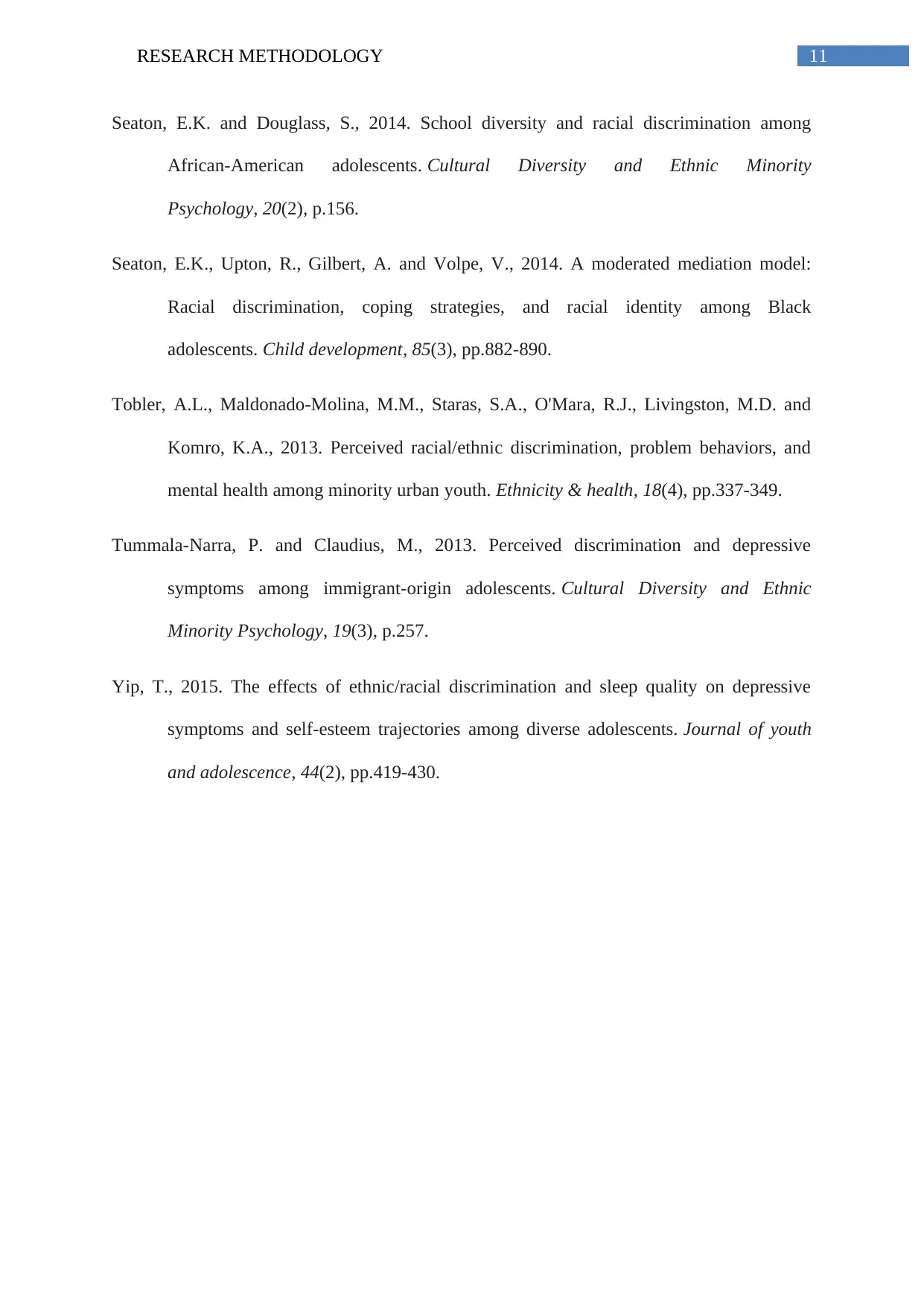
11RESEARCH METHODOLOGY
Seaton, E.K. and Douglass, S., 2014. School diversity and racial discrimination among
African-American adolescents. Cultural Diversity and Ethnic Minority
Psychology, 20(2), p.156.
Seaton, E.K., Upton, R., Gilbert, A. and Volpe, V., 2014. A moderated mediation model:
Racial discrimination, coping strategies, and racial identity among Black
adolescents. Child development, 85(3), pp.882-890.
Tobler, A.L., Maldonado-Molina, M.M., Staras, S.A., O'Mara, R.J., Livingston, M.D. and
Komro, K.A., 2013. Perceived racial/ethnic discrimination, problem behaviors, and
mental health among minority urban youth. Ethnicity & health, 18(4), pp.337-349.
Tummala-Narra, P. and Claudius, M., 2013. Perceived discrimination and depressive
symptoms among immigrant-origin adolescents. Cultural Diversity and Ethnic
Minority Psychology, 19(3), p.257.
Yip, T., 2015. The effects of ethnic/racial discrimination and sleep quality on depressive
symptoms and self-esteem trajectories among diverse adolescents. Journal of youth
and adolescence, 44(2), pp.419-430.
Seaton, E.K. and Douglass, S., 2014. School diversity and racial discrimination among
African-American adolescents. Cultural Diversity and Ethnic Minority
Psychology, 20(2), p.156.
Seaton, E.K., Upton, R., Gilbert, A. and Volpe, V., 2014. A moderated mediation model:
Racial discrimination, coping strategies, and racial identity among Black
adolescents. Child development, 85(3), pp.882-890.
Tobler, A.L., Maldonado-Molina, M.M., Staras, S.A., O'Mara, R.J., Livingston, M.D. and
Komro, K.A., 2013. Perceived racial/ethnic discrimination, problem behaviors, and
mental health among minority urban youth. Ethnicity & health, 18(4), pp.337-349.
Tummala-Narra, P. and Claudius, M., 2013. Perceived discrimination and depressive
symptoms among immigrant-origin adolescents. Cultural Diversity and Ethnic
Minority Psychology, 19(3), p.257.
Yip, T., 2015. The effects of ethnic/racial discrimination and sleep quality on depressive
symptoms and self-esteem trajectories among diverse adolescents. Journal of youth
and adolescence, 44(2), pp.419-430.
⊘ This is a preview!⊘
Do you want full access?
Subscribe today to unlock all pages.

Trusted by 1+ million students worldwide
1 out of 15
Related Documents
Your All-in-One AI-Powered Toolkit for Academic Success.
+13062052269
info@desklib.com
Available 24*7 on WhatsApp / Email
![[object Object]](/_next/static/media/star-bottom.7253800d.svg)
Unlock your academic potential
Copyright © 2020–2025 A2Z Services. All Rights Reserved. Developed and managed by ZUCOL.





